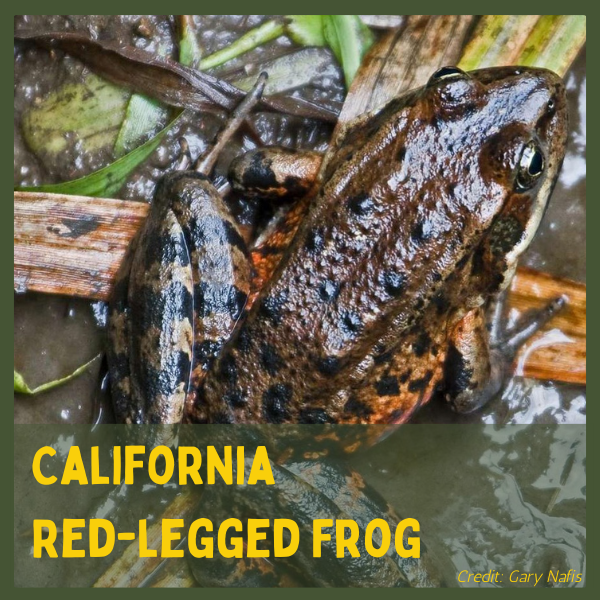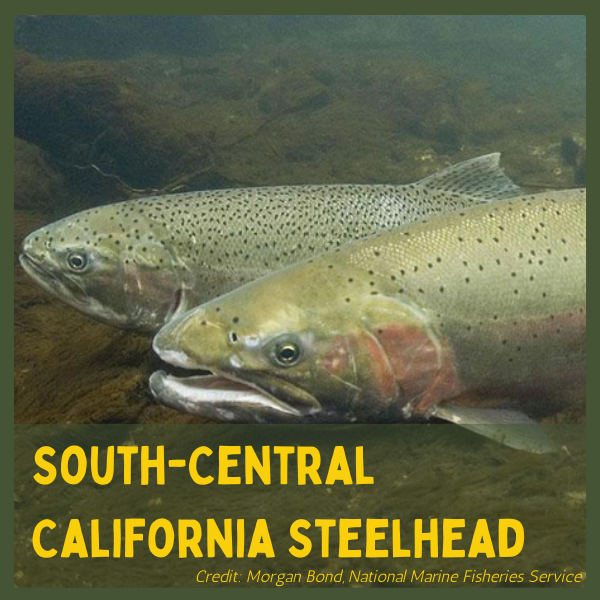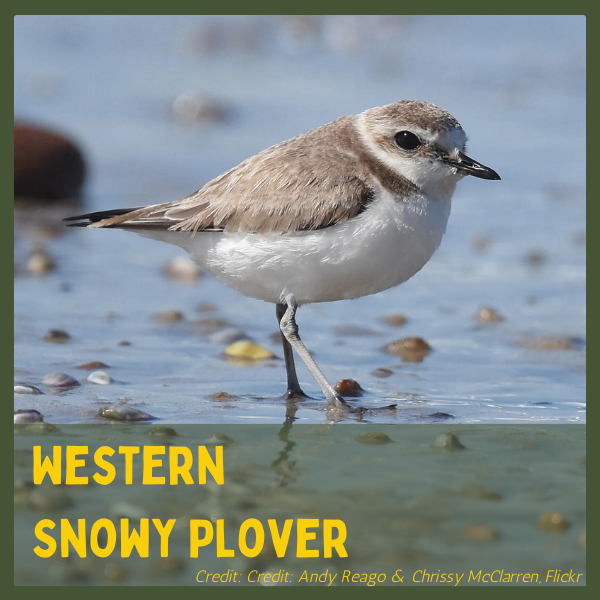Species on the Edge
Species on the Edge

What is the Species on the Edge campaign?
Monterey Peninsula Regional Park District (MPRPD) launched the “Species on the Edge” educational campaign in 2024. The campaign focuses on wildlife that call parks and open spaces home and are listed as threatened or endangered at the federal or state level.
The campaign goals are to increase community awareness of endangered and threatened species, educate on how your behavior impacts species on the edge, and convey the message that you are a part of nature, not apart from it.
You can help protect these species and their sensitive habitats in the coastal dunes, wetlands, and rivers.
Want to learn more?
- Read more about each species and their habitats below.
- Become a volunteer.
- Participage at our special events throughout the year. Events and volunteering opportunities are regularly shared through our social media @mprpd_lgo and Facebook.


California Red-Legged Frog (Rana draytonii)
Federally Listed - Threatened Species
Why am I listed?
I’ve lost 70% of my former range, especially historical wetland areas like the entire Central Valley of CA.
Where am I?
I can be found in coastal drainages from the Bay area to Baja California, Mexico, and Sierra foothills. I mate and migrate during the rainy season between November and May.
What impacts me?
My species struggles to survive because my wetland habitats have been developed, my skin quickly absorbs pollutants and pesticides, and a highly competitive, invasive species, the American bullfrog, likes to eat my young and compete for food.
How can you help me?
- Avoid using pesticides/contaminants.
- Don’t disturb possible breeding waters after rain events.
- Watch for frogs and tread carefully, especially after rains and at dawn & dusk.
- Never pickup amphibians, salamanders, and newts as they breathe through their skin.
Learn more at the US Fish & Wildlife Service: California Red-Legged Frog
South-Central California Steelhead (Oncorhynchus mykiss)

Federally Listed - Threatened Species
Why am I listed?
Low water and poor river conditions have left my southern populations struggling and left me at risk of extinction.
Where am I?
I can be found along the Pacific coast of the US, but my sub-species hangs out between Santa Cruz and Santa Barbara. I return to my home rivers after years at sea starting in March and through the summer.
What impacts me?
My rivers are going dry in the summer and human development is removing wild areas where I shelter and feed. As a juvenile I struggle to make it all the way to the ocean, and when I return after years in the ocean it is a struggle to make it up to the gravel river beds where I lay my eggs.
How can you help me?
- Plant natives on riverbanks.
- Volunteer for Carmel River Steelhead Association fish rescues.
Learn more at NOAA Fisheries: South-Central California Steelhead
Tricolored Blackbird (Agelaius tricolor)

State Listed - Threatened Species
Why am I listed?
My population has declined 85% since the early 1900’s because of major loss of my wetland breeding habitat. With less than 90% of California’s original wetlands still in place, we have adapted to nest in agriculture fields.
Where am I?
My species of blackbird is unique and almost entirely found (endemic) in California, mostly in coastal regions and the Central Valley. I like to find stands of cattail and tule in freshwater wetlands for roosting and nesting in the Spring and Summer.
What impacts me?
My dense colonies are vulnerable to continued loss of my wetland habitats and agriculture practices, like mowing, in the fields where I’ve adapted to nest.
How can you help me?
- Restore my wetland habitat.
- Avoid pesticide use.
- Avoid mowing fields until my babies have left the nest.
Learn more at the US Fish & Wildlife Service: Tricolored Blackbird
Smith’s Blue Butterfly (Euphilotes enoptes smithi)
Federally Listed – Endangered Species

Why am I listed?
My only habitat is my host plants, the coast and dune buckwheat. In fact I rarely move more than a meter from the plant I was born on. With the loss of continuous dune and grasslands where buckwheat grow, my populations have declined.
Where am I?
I’m only found on the Central Coast of California in habitats suitable for my host plant like dunes, grasslands, and chaparral. I lay my eggs near the buckwheat I grew up on in the summer from June to August.
What impacts me?
Human development and invasive plants reduce my habitat, I can’t live if my host buckwheat cannot grow.
How can you help me?
- Join restoration groups in the Monterey Bay dune complex.
- Stay on trails in coastal dune habitat.
Learn more at the US Fish & Wildlife Service: Smith’s Blue Butterfly
Western Snowy Plover (Charadrius nivosus nivosus)

Federally Listed – Threatened Species
Why am I listed?
My Pacific Coast population is less than 2,500 other birds because of loss of my dune habitats and disturbance of my nesting sites.
Where am I?
I live on sandy beaches and dunes along the Pacific coast. My nesting season is March-September when I dig a very shallow bowl in the sand and lay my camouflaged eggs. Careful where you step!
What impacts me?
My nests are hard to see and many predators like crows and racoons scare me from my nest. I am especially likely to hide and leave my nest unprotected for hours when dogs and their humans scare me away.
How can you help me?
- Keep dogs on leash at the beach.
- Stay out of posted nesting sites.
Read more about Western snowy plover in an article from our April 2024 e-newsletter
Learn more at the US Fish & Wildlife Service: Western Snowy Plover
